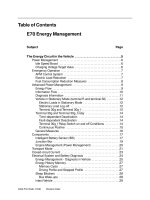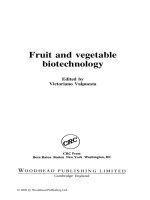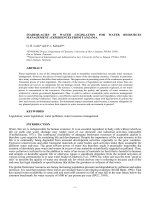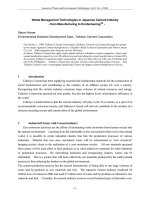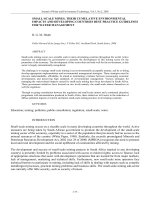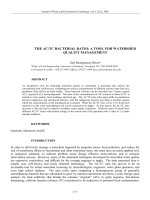fruit tree management timetable
Bạn đang xem bản rút gọn của tài liệu. Xem và tải ngay bản đầy đủ của tài liệu tại đây (368.2 KB, 4 trang )
SP307-D
Fruits and Nuts
Fruit Tree Management Timetable
David W. Lockwood, Professor
Plant Sciences
Fruit production is a “year-round” job. For opti-
mum results, each task should be done at a specifi c
time of the year. These are shown in the diagram on
page 3.
Fertilizing
Apply fertilizers approximately one month prior
to the initiation of growth in spring. Refer to SP307-A,
“Fertilizing and Liming Fruit Trees,” for more in-
formation. For types of fruits where frost damage
frequently occurs, consider applying one-half the
recommended rate of fertilizer at the time indicated
above. If no frost injury occurs and bloom was heavy,
apply the second half of the recommended rate of fer-
tilizer soon after bloom. Where frost damage has re-
sulted in severe crop reduction, eliminate or reduce the
second fertilizer application to reduce excess vegeta-
tive growth.
Planting
Bare-root fruit trees should be planted from mid-
February to mid-March. This assures good root-soil
contact so plants can become established prior to the
initiation of top growth. Refer to SP307-B, “Planting
Fruit Trees,” for more information.
Pre-Bloom Sprays
These sprays include applications of dormant oils
as well as fungicides for scab, rusts, mildews and other
diseases, plus insecticides for early season insect con-
trol. Refer to Extension PB 1622, “Disease and Insect
Control in Home Fruit Plantings,” for information on
specifi c pesticides, rates and timing.
Pruning
Make large cuts when trees are completely dor-
mant. Detailed pruning of stone fruits (peaches, nectar-
ines, plums) should be delayed until after the danger of
frost is past.
Bloom Sprays
Fireblight on apples and pears and blossom blight
on stone fruits are examples of two disorders that re-
quire special sprays during blossom. Bees are essen tial
for good pollination; do not apply insecticides at this
time to protect them. Refer to Extension PB 1622,
“Disease and Insect Control in Home Fruit Plantings,”
for additional information.
Cover Sprays
Many insects and diseases will cause severe dam-
age to fruits and foliage if left unchecked. Timely and
thorough applications of the proper pesticides will as-
sure higher quality fruit, healthier trees and higher
yield of crops than will be obtained from unsprayed
trees. Extension PB 1622, “Disease and Insect Control
in Home Fruit Plantings,” contains information on
these sprays.
Fruit Thinning
Often, trees will set larger crops of fruit than they
can handle. Removal of some fruit will result in in-
creased size and quality of the remaining fruits, plus
larger crops the following year. Thinning should be
done when developing fruits are about the size of a
nickel. Thin the earliest-ripening varieties fi rst. Space
fruit between 6 and 8 inches apart on the branches.
Hand thinning gives the best results. Avoid spraying
apples with Sevin insecticide within 30 days of bloom
as it may thin apples. Chemical thinning is not rec-
ommended for home orchardists. Refer to SP307-E,
“Fruit Thinning,” for additional information.
Peach Tree Borer Sprays
Protect stone fruit trees by spraying the tree trunks
during the summer months. For best control, thorough
coverage of the trunk and basal part of the scaffold
limbs with the spray solution is essential. Refer to
Extension PB 1622, “Disease and Insect Control in
Home Fruit Plantings,” for additional information.
Order New Trees
To increase the chances of getting the size,
variety and rootstock fruit trees you want, order them
early. This is especially important for large orders or
for varieties that are in strong demand. Order trees
from reputable nurseries.
Harvesting
Recommended peach varieties for Tennessee will
ripen from late June through late August. Plums will
ripen from mid-June through mid-July. The ripening
time for apples is from early July through mid-October,
depending on variety and location.
Soil Testing
Before planting fruit trees and every third to fi fth
year after planting, soil test the orchard site. Proper
soil pH and nutrient levels are essential for good tree
survival, growth and fruiting. Contact your county
Extension offi ce for information and materials. Refer
to SP307-A, “Fertilizing and Liming Fruit Trees,” for
additional information.
Rodent Control
Pine vole, meadow vole, prairie vole and cot-
ton rat are all problems in orchards in various parts of
Tennessee. Control methods include maintaining bare
soil under the trees, mowing row middles and orchard
perimeters throughout the summer, installing tree
guards and removing or crushing dropped fruit. Where
rodent problems in commercial orchards exist, roden-
ticides may be used effectively. Apply them from late
October through early December.
Peach Leaf Curl Spray
Peach leaf curl is a disease that may be controlled
by spraying during the period from leaf drop in fall up
to bud swell in spring. Refer to Extension PB 1622,
“Disease and Insect Control in Home Fruit Plantings,”
for more information.
Painting Tree Trunks
Winter injury to tree trunks (also called south-
west trunk injury) may be a severe problem in all fruit
trees. Painting the lower 24 inches of tree trunks with
a white latex paint will reduce trunk heating and sub-
sequent tree damage in winter months. Apply paint on
days with good drying conditions (warm, breezy) to
minimize the risk of trunk injury.
Weed and Grass Control
Competition for moisture and nutrients is one
of the main reasons to control vegetation under fruit
trees. Reduction in insect, disease and rodent problems
also may be recognized. Control methods include hand
weeding, shallow cultivation, close mowing and using
herbicides. This is a “year-round” job.
January
February
March
April
May
June
July
August
September
October
November
December
1
4
.
P
a
i
n
t
i
n
g
T
r
e
e
T
r
u
n
k
s
1
3
.
P
e
a
c
h
L
e
a
f
C
u
r
l
S
p
r
a
y
1
2
.
R
o
d
e
n
t
C
o
n
t
r
o
l
1
5
.
W
e
e
d
a
n
d
G
r
a
s
s
C
o
n
t
r
o
l
4
.
P
r
u
n
i
n
g
1
.
F
e
r
t
i
l
i
z
i
n
g
2
.
P
l
a
n
t
i
n
g
5
.
B
l
o
o
m
S
p
r
a
y
s
3
.
P
r
e
-
B
l
o
o
m
S
p
r
a
y
s
7
.
F
r
u
i
t
T
h
i
n
n
i
n
g
9
.
O
r
d
e
r
N
e
w
T
r
e
e
s
6
.
C
o
v
e
r
S
p
r
a
y
s
1
0
.
H
a
r
v
e
s
t
i
n
g
1
1
.
S
o
i
l
T
e
s
t
i
n
g
8
.
P
e
a
c
h
T
r
e
e
B
o
r
e
r
S
p
r
a
y
s
SP307-D–5M–5/06 (Rep) E12-5115-00-005-06
Visit the UT Extension Web site at
/>Programs in agriculture and natural resources, 4-H youth development, family and consumer sciences, and resource development.
University of Tennessee Institute of Agriculture, U.S. Department of Agriculture and county governments cooperating.
UT Extension provides equal opportunities in programs and employment.

